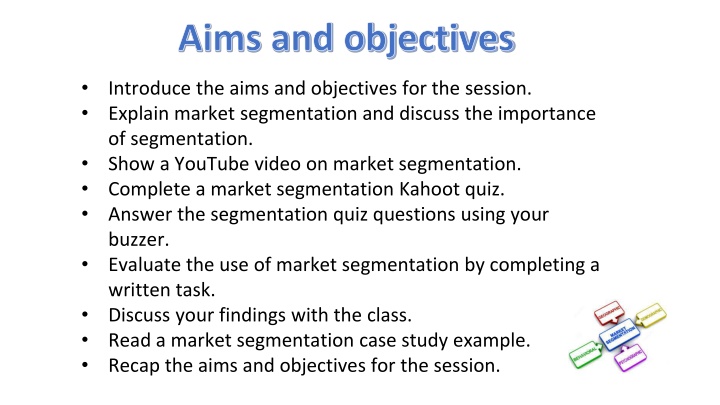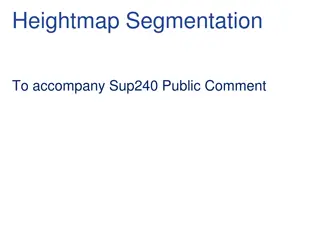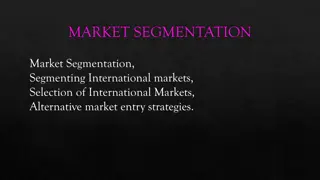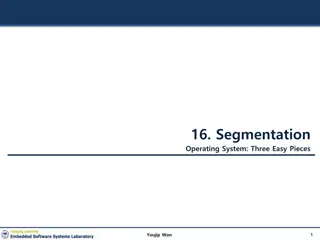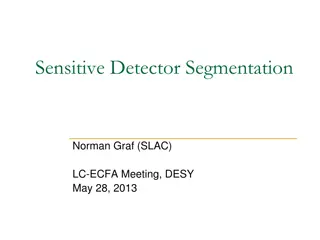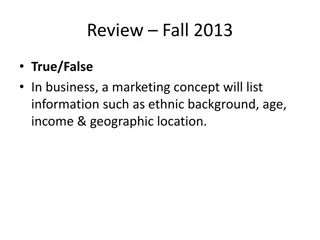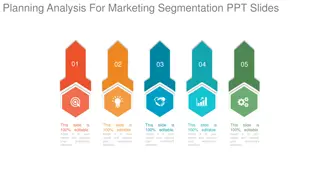Mastering Market Segmentation: A Comprehensive Session Plan
Explore the world of market segmentation through an interactive session plan. Understand the significance of segmentation, watch a YouTube video, engage in a Kahoot quiz, evaluate segmentation strategies, and review a case study. Dive into demographic, psychographic, and geographic segmentation characteristics to grasp its applications in real-world scenarios.
Download Presentation

Please find below an Image/Link to download the presentation.
The content on the website is provided AS IS for your information and personal use only. It may not be sold, licensed, or shared on other websites without obtaining consent from the author.If you encounter any issues during the download, it is possible that the publisher has removed the file from their server.
You are allowed to download the files provided on this website for personal or commercial use, subject to the condition that they are used lawfully. All files are the property of their respective owners.
The content on the website is provided AS IS for your information and personal use only. It may not be sold, licensed, or shared on other websites without obtaining consent from the author.
E N D
Presentation Transcript
Aims and objectives Introduce the aims and objectives for the session. Explain market segmentation and discuss the importance of segmentation. Show a YouTube video on market segmentation. Complete a market segmentation Kahoot quiz. Answer the segmentation quiz questions using your buzzer. Evaluate the use of market segmentation by completing a written task. Discuss your findings with the class. Read a market segmentation case study example. Recap the aims and objectives for the session.
Activity 1 Task: Using your show me boards discuss : Market segmentation. The main bases of segmentation. Time : 5 mins
Market segmentation A market segment is any sub-group of a larger market. Mass market businesses divide their target markets into segments (sub-groups) that have common features, or are made up of individuals that make purchasing decisions based on common factors. When this is done businesses produce and market products aimed at each of these segments.
Types of segmentation Demographic Age, social class, gender, income. Example: Banks offer different accounts to different age groups.
Psychographic Allows targeting of groups on personality and emotionally based behaviour attitudes, opinions and lifestyles. Example: Differentiating cars by emphasising different features safety and capacity for the family car
Types of segmentation Geographic Regions of the country rural, urban, suburban. Global marketing often requires different products for different countries. Example: Global brands such as McDonalds and Coca Cola require different ingredients in different countries
Segmentation characteristics Firstly, segments must be recognisable. They must be different enough from other segments to make producing for that segment worthwhile. For example : Housing is built for different groups of people: flats for single people, two bedroom houses and starter homes for young couples, three or four bedroom houses for families, bungalows for retired people.
Segmentation characteristics Also segments must have critical mass. This means that they must be big enough or produce enough sales value to make the production of products or services targeted at the segment worthwhile. The market for two-seater sports cars has grown rapidly in recent years making the segment attractive: Not only to niche market businesses such as Lotus, but also to mass market businesses like Toyota, Honda and Nissan.
Segmentation characteristics Segments have to be targetable. Having their own identity means that they can be promoted to, and have marketing directed towards them. On daytime TV, there are many adverts for retirement plans, or funeral expenses plans, often sold in a reassuring but concerned manner. They are targeted at a segment which is aware of the potential problems of costly funeral expenses, or leaving a loved one without financial support.
Segmentation characteristics Once segments have been identified, then businesses can use a target marketing approach. Targeted marketing allows the business to stress those product features that are most relevant for each particular segment (e.g. price vs. quality vs. brand identity). This targeting will occur even if the product being sold to different segments is almost identical.
Segmentation Changes Finally, customers change their preferences and patterns of behaviour over time (the customer life cycle). Sustainable customer relationships in all phases of the customer life cycle can come from segmenting markets. Businesses that serve different segments along a customer s life cycle can lead their customers from stage to stage by always offering them a special solution for their particular needs.
Segmentation examples For example, most car manufacturers offer a product range that caters for the needs of all phases of a customer life cycle: A first car for students/young workers, a fun car for young professionals, a family car for young families, SUV for growing families etc.
Skincare cosmetics brands often offer a branded series of products for babies, teens, young adults, mums, and more mature skin.
Seasonal markets Many markets have large seasonable variations. Classic examples are ice cream (during the pre-summer period), fireworks and diet plans (in January). Seasonal marketing will have a huge influence on the activities of businesses involved in these industries as each will have a critical sales period, which can make or break a business.
Seasonal markets Few businesses are totally immune to seasonality of sales. Lines of stock are adapted and changed the big supermarkets have titled seasonal aisles. All of these seasonal changes have to be thought about and planned several months in advance to ensure that all aspects of the marketing mix are in place when required.
YouTube video Segmentation https://www.youtube.com/watch?v=DUuirqtSqpg
Handout Market segmentation You will receive a handout on market segmentation.
Activity 2 Task: Kahoot quiz - Segmentation Time: 20 mins
Market segmentation questions 1. What is market segmentation? 2. How are markets segmented? 3. What are the bases of demographic segmentation? 4. Can you explain psychographic segmentation? 5. What is geographic segmentation? 6. Why do companies segment markets? 7. Give an example of market segmentation?
BREAK 15 mins
Activity 3 Task: Your task is to explain the main bases of segmentation in a written task. Time: 30 mins and 10 mins discussion.
Activity 3 Task: Segmentation case study example Time: 15 mins
Aims and objectives Introduce the aims and objectives for the session. Explain market segmentation and discuss the importance of segmentation. Show a YouTube video on market segmentation. Complete a market segmentation Kahoot quiz. Answer the segmentation quiz questions using your buzzer. Evaluate the use of market segmentation by completing a written task. Discuss your findings with the class. Read a market segmentation case study example. Recap the aims and objectives for the session.
